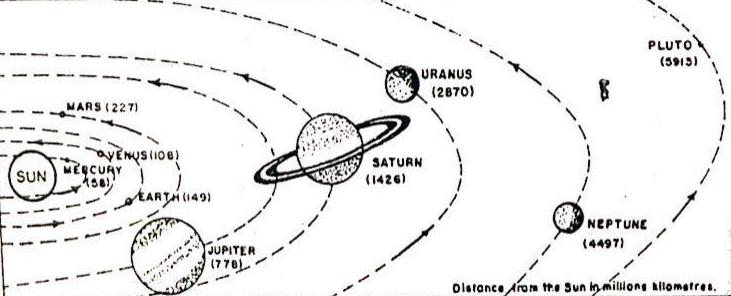Our Solar System and Earth 31/05/2019 – Posted in: NCERT
OUR SOLAR SYSTEM AND EARTH
| TERMS THAT YOU MUST KNOW
Star: A celestial body having its own heat and light. Planet: A celestial body which revolves round the sun and receives heat and light from it. Satellite: A celestial body which revolves round a planet just as a planet revolves round the sun. Celestial Bodies: the moon and millions of bright objects seen during the night that belong to the sky are called celestial bodies. Stars: Some celestial bodies have their own heat and light and are called stars. They are actually very big and hot bodies made of gases. The sun is also a star. Orbit: All the planets of the solar system revolve around the sun counter clockwise in elliptical paths known as Orbits. Asteroids: A swarm of small bodies in between the orbit of Mars and Jupiter, which revolves around the Sun. Galaxy: A family or system of millions and millions of stars. Universe: The Vast and infinite space having millions of galaxies. |
Solar System
Our planetary system is located in an outer spiral arm of the Milky Way galaxy.
Our solar system consists of our star, the Sun, and everything bound to it by gravity — the planets Mercury, Venus, Earth, Mars, Jupiter, Saturn, Uranus and Neptune, dwarf planets such as Pluto, dozens of moons and millions of asteroids, comets and meteoroids.
The Sun
The sun is in the centre of the solar system. It is the biggest member of the family. It is million times larger than our earth.
It is made of extremely hot gases. It is the source of all energy i.e. heat and light for the entire solar system. Without this energy the earth would be cold and lifeless.
The sun is about 150 million kilometers away from the earth. Light travels with a tremendous speed of about 300,000 kilometer per second. Yet, even with this speed, the light of the sun takes about eight minutes to reach the earth.
Asteroids
Between the orbits of Mars and Jupiter, there is a swarm of small bodies which also revolve round the sun. They are called Asteroids. They are believed to be the pieces of planets which probably exploded after its birth.
All the planets of the solar system revolve around the sun counter clockwise in elliptical paths known as Orbits. All of them move in the same direction in their revolutions. The planets also rotate on their own axes. Except Venus and Uranus, all other planets rotate in the same direction in which they revolve.
As the distance of the planet from the sun increases, the time taken by it to complete one revolution also increases.
Since Mercury is nearest to the sun, it takes only about 88 days to complete one revolution.
Our earth revolves one in about 365 days and 6 hours.
Pluto takes about 248 years to complete one revolution. Since Pluto is farthest from the sun hence it is the coldest planet (dwarf) in the solar system.
Earth
The earth is our planet. It is the third nearest planet to the sun. In size, it ranks fifth.
Like other planets, the earth is also a sphere. It is slightly flattened at the poles. In size and shape the earth is almost identical to Venus.
It is the only known planet of the solar system where life is possible. It is because of presence of presence of water, moderate temperature and moderate dense atmosphere containing gases useful in supporting life on the earth.
Astronauts, who have seen the earth from space, say that the earth appears blue in colour. It is because of the presence of water. It is therefore, also called a blue planet.
Satellites
The word ‘satellite’ means a smaller companion to anything. True to their meaning, these satellites revolve around their planets and also follow them in their revolution around the sun.
The moon for example, is a satellite of the earth which moves around the earth and also around the sun along with the earth.
Except Mercury and Venus, all the other planets have one or more satellites. Like planets, the satellites too have no light of their own. They just reflect the light received from the sun.
The Moon (Earth’s Satellite)
Our earth has only one satellite, i.e., the moon.
The diameter of the moon is openly one-fourth of that of the earth. It appears so big because it is very close to us.
It is about 385,000 kilometers away from us. The light reflected by the moon reaches us in just one and a quarter seconds.
The moon revolves round the earth in about 27 days and 8 hours.
It is now known that there is no air or water on the moon. It is very hot during the day and very cold during the night. Its surface is very uneven and there is no soil.
The Earth in the Universe
Our planet earth, which appears so big, is just a tiny speck in the vast space. It is just one of the members of the solar system. Like our solar system, millions of star systems make on galaxy is the MILKY WAY.
There are perhaps millions of galaxies in the whole universe. It is very difficult t imagine the vastness of our universe. The distances in the universe are measured in light years – the distance light travels in one year. The light of the nearest star (Proxima Centauri) to the sun reaches us in about four years. The light of some stars may take millions of years to reach us. There are countless stars whose lights are still travelling but have not reached us yet.
Source: NCERT
You can follow us on LinkedIn and for more updates related to UPSC IAS Preparation. Like our Facebook Page and subscribe our Diligent IAS Youtube Channel

